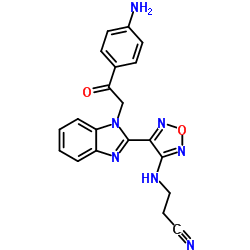| In Vitro |
Avanbulin (0-4 μM) binds to tubulin with an apparent Kd value of 244 nM[1]. Avanbulin (0-20 μM) and Colchicine (0-10 μM) are competitive for binding to tubulin with an apparent Ki value of 1.8 μM[1]. Avanbulin binds to the same site as Colchicine at the intradimer interface[1]. Avanbulin (50 μM; 0, 10, 20, 30, 60 min) induces the proteolysis of tubulin[1]. Avanbulin (1-100 nM; 72 h; HeLa-tubGFP cells) has anti-proliferative effects[1]. Avanbulin (33 nM; 0, 10, 20, 30, 60 min; HeLa-tubGFP cells) collapses the mitotic spindle and forms the tiny tubulin aggregates[1]. Avanbulin does not induce the formation of tubulin oligomers[1]. Avanbulin (0.1 nM-1.0 μM; 96 hours) induces growth inhibition of cells with a median relative IC50 of 13.8 nM[2]. Avanbulin (0-1,000 nM; 3 days) inhibits the growth of glioblastoma cancer stem-like cells, GBM6 (EC50=20.8 nM) and GBM9 (EC50=21.7 nM) [3]. Avanbulin (6 nM and 20 nM) inhibits the migration of GBM6 and GBM9 cells[3]. Avanbulin (6 nM and 20 nM; GBM6-shEB1 and GBM6-sh0 cells) triggers astrocytic differentiation of GBM6 in an EB1-dependent manner[3]. Avanbulin (12 nM; 4 h) reduces kinetochore-microtubule (KT–MT) occupancy of MG132(10 μM; 2h) treated hTert-RPE1 eGFP-α-tubulin cells[4]. Avanbulin (12 nM; 4 h) reduces average inter-KT distances of cells[4]. Avanbulin-treated (12 nM; 4 h) cells show intact spindle morphology and lack of obvious chromosome alignment defects[4]. Cell Cytotoxicity Assay[2] Cell Line: 23 cell lines, including RD, TC-71, SJ-GBM2, NB-1643. Concentration: 0.1 nM-1.0 μM Incubation Time: 96 hours Result: Induced growth inhibition of cells with a median relative IC50 of 13.8 nM.
|
